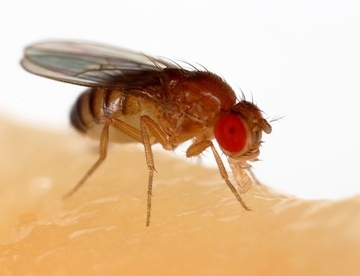- Author: Kathy Keatley Garvey

The seminar, part of the UC Davis Department of Entomology and Nematology's weekly fall seminars, begins at 4:10 p.m. The Zoom link: http://ucdavis.zoom.us/j/99515291076.
"Since its 2008 detection in North America, management of the invasive Drosophila suzukii has primarily relied on calendar insecticide applications, creating a scenario where selection pressure from frequent insecticide
applications could result in development of insecticide resistance," Ganjisaffar says in her abstract.
"Field-derived resistance to spinosad has already been documented in California caneberry production, and there is significant concern among berry and cherry growers for development of resistance to other insecticides," she wrote. "This seminar will present the status of our ongoing studies to assess development and extent of insecticide resistance in California D. suzukii populations, seasonal changes in resistance, stability of resistance and potential cross-resistance between chemical classes, as well as our work on the behavioral control of D. suzukii and evaluating the efficacy of some Attract-and-Kill products."
Ganjisaffar joined the Zalom lab in August 2020 from UC Riverside where she served as a postdoctoral scholar after receiving her doctorate in entomology there in 2016. She was a member of the UC Riverside team that won second place in theESA's Linnaean Games (now Entomology Games). She received a University of California Dean's Distinguished fellowship in 2011.
Zalom, a UC Davis distinguished professor of entomology, is a past president of the Entomological Society of America (ESA) and was recently named Honorary Member of ESA, the organization's highest honor.
Ganjisaffar holds a bachelor's degree in agricultural engineering/plant protection (2006) from the University of Tehran, Tehran, Iran, and a master's degree in agricultural entomology (2009) from Tarbiat Modares University, Tehran.
Her most recent publications include:
- Life History Evaluation of Ooencyrtus lucidus, a Newly Described Egg Parasitoid of Bagrada hilaris
Journal, Insects, May 9, 2020 - Lethal and Sub-Lethal Effects of Insecticides on the Pink Hibiscus Mealybug, Maconellicoccus hirsutus (Hemiptera: Pseudococcidae)
Journal, Insects, - Mutual interference between adult females of Galendromus flumenis (Acari: Phytoseiidae) feeding on eggs of Banks grass mite decreases predation efficiency and increases emigration rate
Experimental and Applied Acarology,
The UC Davis Department of Entomology and Nematology seminars are held on Wednesdays at 4:10 p.m. All in-person seminars are held in 122 Briggs Hall, while the virtual seminars are broadcast on Zoom. For more information, contact coordinator Shahid Siddique, nematologist and assistant professor, at ssiddique@ucdavis.edu.

- Author: Kathy Keatley Garvey

His seminar is set for Wednesday, Feb. 13 from 4:10 to 5 p.m. in 122 Briggs Hall, off Kleiber Hall Drive.
"I will talk about the molecular mechanisms involved in seasonal adaptation in insects," Brieux said. "Overwintering insects undergo profound physiological changes characterized by an arrest in development and reproduction in adults, known as diapause. While the hormonal control of reproductive diapause is relatively well described it is still unclear how organisms interpret variations in photoperiod (daylength) and temperature to modulate their physiology in order to survive through unfavorable seasons."
"In this context I will present the progress we made in the characterization of a key mechanism signaling seasonal changes in insects and how it can promote our understanding of animal seasonal timing in a comparative framework. In addition, future work on this aspect is also expected to have a broad significance in understanding the evolutionary response of pest insects to rapid climate change."
Says Brieux: "Arguably, the most well recognized seasonal response in insects is the induction of overwintering diapause, which can be induced at different life stages, and is characterized by arrest in growth and reproduction. Since PPTM is critical to seasonal adaptation in insects, it has been studied extensively. Yet, the molecular and neuronal basis of the insect photoperiodic timer has evaded characterization."
The overall goal of this study, he says, is "to address the long-standing knowledge gap using the genetically tractable Drosophila melanogaster and the migratory butterfly, the monarch, Danaus plexippus, as complementary model."
"Specifically, we propose to investigate the mechanisms by which the seasonal timer interprets and signals changes in photoperiod to elicit downstream neuroendocrine and physiological responses in insects."
Brieux received his bachelor's degree in biology in 2009 and pursued a master's degree from Pierre and Marie Curie University, Paris, France. He finished his doctorate in 2014 with faculty members Line Duportets and Christophe Gadenne at Angers University, western France, where he investigated the role of hormones and biogenic amines in the behavioral response to the sex pheromone in the noctuid Agrotis ipsilon.
The postdoctoral scientist joined the Chiu lab in the spring of 2016. In addition to his passion for research, Brieuz is a talented photographer passionate about macrophotography. Check out his photos on his website.
Associate professor Joanna Chiu, a molecular geneticist and physiologist, serves as the vice chair of the UC Davis Department of Entomology and Nematology, and is a newly selected Chancellor's Fellow. Her research expertise involves molecular genetics of animal behavior, circadian rhythm biology, and posttranslational regulation of proteins.



